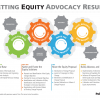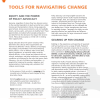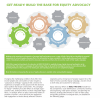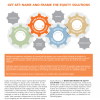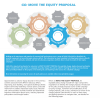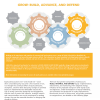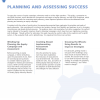
GEAR -- Getting Equity Advocacy Results
- strengthen the effectiveness of equity advocacy
- identify opportunities to drive change
- obtain feedback for improvement
- demonstrate results
GEAR Introduction
- strengthen the effectiveness of equity advocacy
- identify opportunities to drive change
- obtain feedback for improvement
- demonstrate results
GEAR in Action
GEAR Components
Getting Equity Advocacy Results means not only working toward a major equity goal, but also successfully achieving important steps for equity along the way.
GEAR provides advocates a way of thinking about their work, as well as a tangible and straightforward means for navigating the markedly nonlinear practice of equity advocacy.
GEAR includes four major parts: gray gears, color gears, an interwoven chain, and benchmarks.
Organizing, capacity building, research, and communications — the gray gears — are ongoing and critical components of advocacy campaigns for equity. They promote community inclusion in determining outcomes, and drive advocates from one stage of a campaign to another.
The four stages of equity advocacy — the color gears — each focus on different advocacy activities, and produce different equity results. The major stages are to: Build the Base, Name and Frame the Equity Solutions, Move the Equity Proposal, and Build, Advance, and Defend. Campaigns may involve one or several stages, and advocates might move between them in different sequences.
Build the Base
Name and Frame the Equity Solutions
Move the Equity Proposal
Equity campaigns are characterized by four major stages. The four stages of equity advocacy each focus on different developments in a campaign, and each produces different kinds of equity results. Campaigns may involve one or several stages, and advocates might move between them in different sequences.
Opportunities to advance equity abound in the numerous activities associated with different advocacy efforts. Organizing, base building, and capacity-building activities expand community leadership, increase power, and build momentum to address important equity issues. Research and communications activities illustrate and disseminate important information about issues, reaching important policymakers and thought leaders.
Efforts to MOVE THE EQUITY PROPOSAL for equitable policy change include five major components: negotiations to develop the change proposal, introduction of the policy change proposal, launch of the campaign for policy change, movement and modification of the change proposal, and success, redirection or failure of the change proposal. Benchmarks for each of these areas, and guiding questions to navigate them, are available for download.
Build, Advance and Defend
Equity campaigns are characterized by four major stages. The four stages of equity advocacy each focus on different developments in a campaign, and each produces different kinds of equity results. Campaigns may involve one or several stages, and advocates might move between them in different sequences.
Equity advocacy does not — and should not — cease when a favorable policy outcome is first reached. In fact, it is through the continued effort of equity advocates, champions, and their allies that policy changes to promote equity are implemented and imbedded into practice. Just as strong community leadership and engagement, effective uses of power and influence, strategic research and communications are crucial components to seeding change, they are also essential elements for bringing that change to fruition.
There are four general components of advocacy to BUILD, ADVANCE, AND DEFEND equity: implementation, enforcement, and monitoring of the adopted change; influence of the proposed change on other equity issues and objectives; further development of equity leadership; and cultivation and protection of equity improvements. Benchmarks for each of these areas, and guiding questions to navigate them, are available for download.
Organizing
- At the BUILD THE BASE stage:
There is a strong and ongoing commitment among collaborative members to one another and to advancing the community vision. - At the NAME AND FRAME THE EQUITY SOLUTIONS stage:
The structure of the campaign and the leadership of the collaborative are assessed upon selection of the policy change objectives and adjusted to ensure authentic community experience, diverse representation, and technical capacity. - At the MOVE THE EQUITY PROPOSAL stage:
Collaborative strength and capacity is sustained through respect to collaborative members’ non-negotiable elements, regular checks of members’ comfort level with strategies, and transparent governance and leadership accountability. - At the BUILD, ADVANCE, and DEFEND stage:
Opportunities for community members to learn about the equity issue and community conditions and to develop skills related to organizing, research, communications, and capacity building are more available and utilized more following implementation.
Capacity Building
The progress of equity advocacy is driven by several activities: organizing, capacity building, communications, and research.
Advocacy capacity must be present from the outset of a campaign, but can be built throughout a campaign by developing community understanding of the policy process and strategies for engagement in the policy process, deepening knowledge of policy facts, and refining skills of strategizing and negotiating with policymakers. A successful campaign also requires leadership savvy to facilitate diverse partnerships, nimbly navigate changing processes, and broker external agreements. Campaign leaders must understand policy processes, have connections to powerful leaders, decision makers, and other key players, and be willing to take risks and make strategic decisions.
Examples of related benchmarks include:
- At the BUILD THE BASE stage:
Paths to leadership within the collaborative are transparent, available to, and endorsed by members of the collaborative. - At the NAME AND FRAME THE EQUITY SOLUTIONS stage:
Community knowledge and expertise and academic and professional research are combined to understand the problem and develop possible policy change objectives. - At the MOVE THE EQUITY PROPOSAL stage:
Enhanced advocacy leadership and the cultivation of new leaders through capacity-building activities expand advocacy for the proposal and support for the overall effort. - At the BUILD, ADVANCE, and DEFEND stage:
Community members gain power through election, appointment, invitation, or other engagement in decision-making entities and processes.
Research
- At the BUILD THE BASE stage:
Initial power mapping reveals individuals, organizations, and interest groups that have the power, both formally and informally, to make, influence, or block decisions regarding possible policy change objectives. - At the NAME AND FRAME THE EQUITY SOLUTIONS stage:
Data and information to understand the problem and possible policy change objectives are disaggregated (e.g., by population, place, race, etc.) and analyzed frequently during the campaign to illuminate the equity dimensions (e.g., consequences for people of different race, class, or gender) of the possible policy change objectives. - At the MOVE THE EQUITY PROPOSAL stage:
Research and information regarding the problem and the proposal are written and shared strategically (e.g., research papers, issue briefs, educational materials, etc.) with target audiences. - At the BUILD, ADVANCE, and DEFEND stage:
Traditional and community-based research reveal increased traction of community input in decision making.
Communications
- At the BUILD THE BASE stage:
The collaborative is committed to implementing and leveraging a strategic communications plan to sharpen its advocacy strategy. - At the NAME AND FRAME THE EQUITY SOLUTIONS stage:
Communications activities (e.g., fact sheets and other written materials, commentary, articles, media interviews, staged media events, etc.) promote awareness and understanding of the problem, and help to broaden understanding and support for the policy change objectives among target audiences. - At the MOVE THE EQUITY PROPOSAL stage:
The framing and messaging employed by the collaborative regarding the problem and the policy change objectives are repeated and used by policymakers in the decision-making process. - At the BUILD, ADVANCE, and DEFEND stage:
Media and framing analyses reveal increased and improved prominence of the equity issue in the public discourse following the introduction and adoption of the policy proposal.
4 Stages of GEAR
- For instance, in one campaign, equity advocates might move sequentially through the stages, starting on the far left, with efforts to Build the Base, before progressing to the right, to Name and Frame the Equity Solutions once the base is formed, and when the solutions are identified, Move the Equity Proposal. If the proposal is adopted, efforts to Build, Advance, and Defend the equity gains can follow.
- Or, the campaign might begin with a strong base intact and ready to respond to a proposal that has suddenly gained public interest. In this case, the campaign might start at the Move the Equity Proposal stage and then theoretically shift gears backwards and forwards, moving back to Name and Frame the Equity Solutions – or even Build the Base – as needed, before advocates could leap ahead to Build, Advance, and Defend equity in an adopted proposal.
- Meanwhile, during the course of a campaign, the focus on research might be most intense just before key decisions are made, while the communications activities ramp up just after. Organizing might be emphasized during base building and while the proposal moves through decision making, whereas capacity building remains a steady focus throughout.
Measurement Strategies
- Benchmarks can be considered the 'mile markers' in campaigns for policy change. Equity advocacy benchmarks include progress on ongoing organizing, capacity building, research, and communications across the campaign stages to Build the Base, Name and Frame Equity Solutions, Move the Equity Proposal, and Build, Advance, and Defend equity.
- Effective strategies for measurement and analysis must match the differing demands, resources, and courses of each equity advocacy campaign. GEAR guidance outlines the important questions advocates must answer to track results. Tips on how to measure and useful resources have been assembled to support assessment efforts.
How To
- Why assess?
- What results matter?
- When to assess?
- Who will lead the assessment?
- What are the right methods to employ?
- What's working? What needs to change?
Why assess?
At the outset of an equity campaign, it is important for stakeholders to come together to consider the value of tracking and assessing their campaign, and to determine the goals and interests to be served by the assessment.
Tools and Resources
- Blackwell, Kwoh, and Pastor have summarized key issues and strategies related to achieving racial equity in America in Uncommon Common Ground: Race and America's Future. Chapter 6 discusses the roles of creating changes both in policy and community leadership to get equity results.
- The Applied Research Center has developed a Racial Equity Impact Assessment Toolkit to help identify how different racial and ethnic groups will be impacted by proposed actions or decisions, such as those included in policy proposals. REIAs are new in the United States but have been used in the United Kingdom for nearly a decade.
- Advocating for Change is an online manual developed by PolicyLink in 2004 to provide an in-depth understanding of the advocacy process for equity. Case studies are shared throughout.
- Advocating for Equitable Development was developed by PolicyLink in 2004 to describe advocacy strategies to build an effective campaign for equitable development.
- Reflect-Action has developed guidance on developing chapatti diagrams for power mapping, to allow advocates and others to analyze power relations, which are important to guide equity campaign strategy.
- In 1999, The Advocacy Institute developed a guide for preparing advocacy case studies. Titled Telling Your Story: A Guide to Preparing Advocacy Case Studies, the guidance can be applied to benchmarks of progress.
- Alliance for Justice offers Bolder Advocacy, a website consolidating a wide range of tools for improving advocacy, including tools for assessing capacity building, resources for community organizing, and others.
- The Aspen Institute hosts Continuous Progress, a website to assist advocates and grantmakers realize advocacy goals through planning and evaluation. The website includes a tool to walk users through the basics of evaluation.
- Blueprint Research and Design drafted a paper in 2005 outlining an approach to prospective advocacy evaluation design. The Challenge of Assessing Policy and Advocacy Activities: Strategies for a Prospective Evaluation Approach includes a discussion of how to use benchmarks, as well as appendices of additional resources.
- The Center for Evaluation Innovation provides a searchable database of publications on advocacy of public policy, communications, strategic learning, and systems change.
- The Centers for Disease Control and Prevention have issued guidance on how to conduct evaluation for improvement of violence prevention organizations. Drafted by Cox, Keener, Woodard, and Wandersman, Evaluation for Improvement: A Seven-Step Empowerment Evaluation Approach for Violence Prevention Organizations includes content applicable to other fields, such as principles of empowerment evaluation and how to find an external evaluator.
- In 2009, Coffman and Reed penned an article titled Unique Methods in Advocacy Evaluation, outlining four methods of self-assessment that advocates can use to get results.
- The Harvard Family Research Project offers a helpful collection of publications and resources on advocacy evaluation.
- The Point K Learning Center, hosted by the Innovation Network, is a clearinghouse of research and information on the evaluation of advocacy and capacity building.
- Klugman penned a 2010 piece called Evaluating Social Justice Advocacy: A Values Based Approach, which discusses the importance of viewing evaluation and advocacy through the lens of social justice.
- Organizational Research Services has produced several tools to advance advocacy evaluation, including the 2007 manual, A Guide to Measuring Advocacy and Policy, and A Handbook of Data Collection Tools: Companion to "A Guide to Measuring Advocacy and Policy," to help advocates use benchmarks and indicators to measure advocacy and policy change. A Training Companion to "A Guide to Measuring Advocacy and Policy", available on CD-ROM, and Speaking for Themselves, a study capturing advocates' perspectives in evaluation, were developed in 2008. Organizational Research Services also drafted Pathways for Change: Six Theories about How Policy Change Happens (2009), a brief that outlines different theories for how policy change happens, and provides examples.
- Michael Quinn Patton, a leader in the field of developmental evaluation, wrote a report on Advocacy Impact Evaluation published in the Journal of Multidisciplinary Evaluation in 2008. It outlines the importance of case studies in tracking advocacy success.
- Community Organizing and Community Building for Health and Welfare, edited by Meredith Minkler, provides important and established ways to approach community building and organizing. The third edition was published in 2012.
- Speer and Zippay wrote the 2005 article Participatory Decision-Making Among Community Coalitions , published in Administration of Social Work in 2005. It offers insights into the analysis of meeting minutes as a strategy for tracking the progress of a campaign or initiative.
- Capacity Building: Linking Community Experience to Public Policy is a resource designed by the Public Health Agency of Canada to help people in both the public sector and the community understand how to include community experience in the policymaking process.
- "Coalition member assessment," written by Tom Wolff, is an informative chapter featured inCommunity Organizing and Community Building for Health and Welfare, edited by M. Minkler.
- "Scale for Measuring Perceptions of Control at the Individual, Organizational, Neighborhood, and Beyond-the-Neighborhood Levels," by Israel, Schulz, Parker, and Becker is a useful tool featured in Community Organizing and Community Building for Health and Welfare, edited by M. Minkler.
- Program to Analyze, Record, and Track Networks to Enhance Relationships (PARTNER) is an online tool to assess partnerships and collaboration.
- Are We There Yet? A Communications Evaluation Guide was developed by Communications Network and Asibey Consulting in 2008 to help advocates improve their communications efforts at the start of a campaign or as a campaign progresses.
- M+R Strategic Services has developed instructions on how to use "power mapping" in communications strategies, which may be useful to advocates planning their equity campaign strategy.
- In 2006, M+R Strategic Services and the Advocacy Institute developed eNonProfit Benchmark Study: Measuring Email Messaging, Online Fundraising, and Internet Advocacy Metrics for Nonprofit Organizations.
- iNews for a Change: An Advocate's Guide to Working with the Media is a guidebook for strategically using media, advertisng, and community organizing to advance a public policy initiative. It was written by Wallack, Woodruff, Dorfman, and Diaz and published in 1999.
- Street Science: Community Knowledge and Environmental Health Justice, discusses the power of community knowledge to transform systems and environments. It includes case studies that illustrate how local community experts might partner with traditional researchers to improve policy outcomes.
- Community Based Participatory Research: From Process to Outcomes, compiled by Minkler and Wallerstein in 2008, features a collection of guidance and case studies for carrying out community-led research to address community priorities.
- Minkler, Garcia, Rubin, and Wallerstein issued recent guidance on how community-based participatory research can impact policy. The report is titled, Community-Based Participatory Research: A Strategy for Building Healthy Communities and Promoting Health through Policy Change: A Report to The California Endowment.
- Stakeholder Involvement in Evaluation: Three Decades of the American Journal of Evaluation, by Rodriguez-Campos, discusses the value and trends in stakeholder engagement in evaluations. It summarizes a review of over 30 years of literature, and was published in 2012.
- People Making Public Policy in California: The PICO California Project,, is an evaluation report that highlights community leadership in policy change. Developed by Paul Speer in May 2002, it provides an important example of how to use research to track advocacy.
- Community Tool Box is an extensive online resource of tools for community change, and includes guidance on conducting participatory & empowerment evaluations and research.
- In an article from a 2010 issue of The Foundation Review, titled Social Movements and Philanthropy: How Foundations Can Support Movement Building, Masters and Osborn identify how foundations can support movement-building. Included is a table of important elements at various stages of a movement.
- In 2012, Pastor, Ito, and Rosner produced Transactions, Transformations, Translations: Metrics that Matter for Building, Scaling, and Funding Social Movements. Guidance on metrics includes discussions of organizing, civic engagement, alliance building, leadership development, and others.


